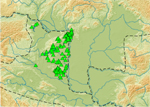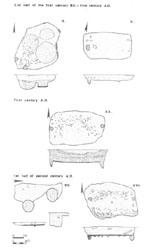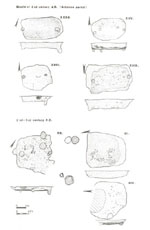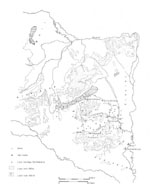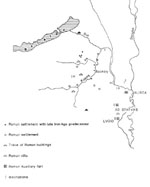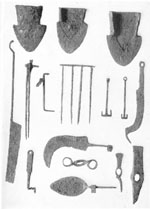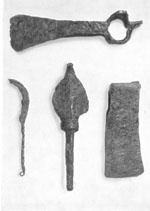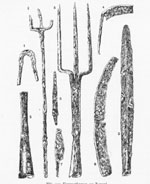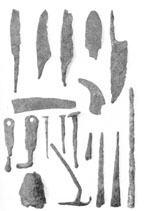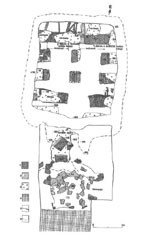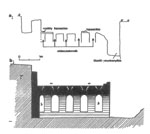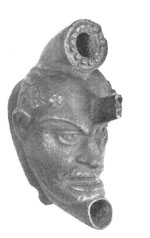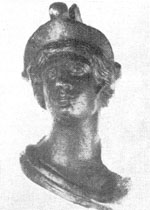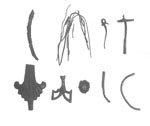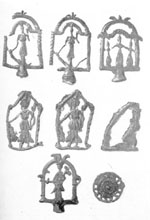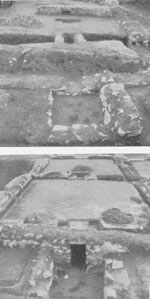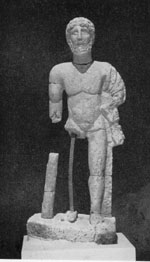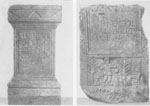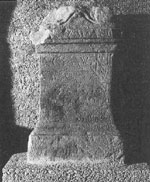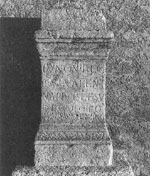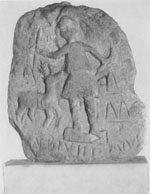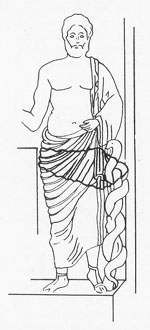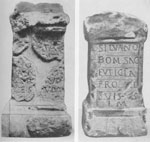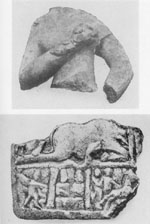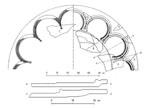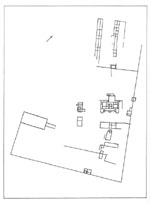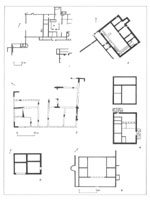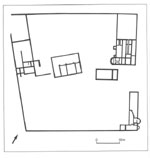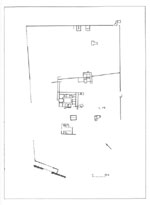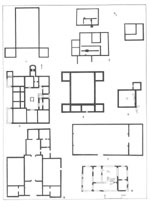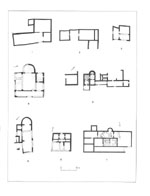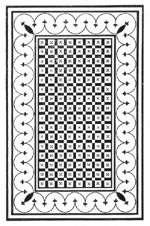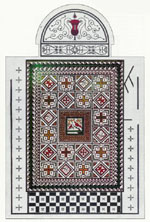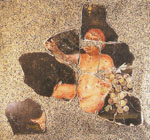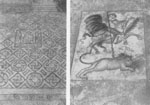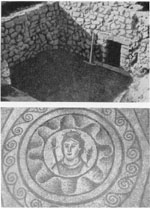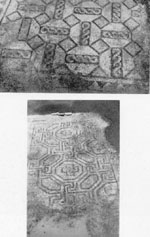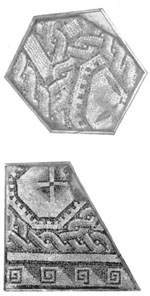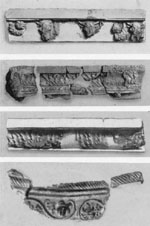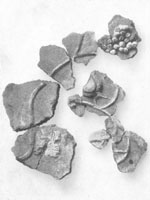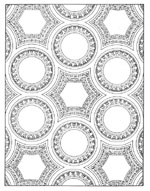Emergence of the landscape of villae
Pre-Roman age settlements
It is very difficult to work up the history of the settlements just before the Roman conquest in Pannonia –especially with regard to the connection between the early settlements and the villae –because of the deficiencies of the research. The Celtic aboriginals lived partly in fortified settlements, oppida (Velem, Gellérthegy, Szalacska, Regöly), and in smaller, village-like settlements without fortification (e.g: Szentendre, Pomáz, Békásmegyer, Albertfalva, Lepsény, Süttő, Lébény, Szakály, Tác-Margittelep, etc.) Mainly the latter settlements without fortification play an important role in the research on the Roman villae. From those territories where later the villae concentrated ( Lake Fertő- area, Balatonfelvidék, Aquincum area), the Lake Fertő area was the accommodation territory of the boii, while the Aquincum territory was that of the tumuli. The settlement established before the Roman conquest are mainly known from the Aquincum area, partly from the territories with favourable potentialities along the Danube, and also from the valleys of the Buda Mountains (Pesthidegkút, Budapest-Kamaraerdő). After the settling of the veterans of the legio XV Apollinaris stationing in Carnuntum, the territory of the celtic boii was forced back to the western edge of the ager Savariensis. The number of the tumuli is the biggest in the noricum-pannonian borderline, east from this only occasionally can we find Celtic names on tombstones as well.
The Romans either totally destroyed the fortified oppida of the aboriginals, or they initiated the settlements along the limes into the frontier defense system, and moved the inhabitants to the internal areas of the province, auxiliary forces taking their place along the limes (e.g. Esztergom, Dunaszekcső, Stari Slankamen). The majority of the non.fortified cletic settlements live to see the conquest, indicated also by the stray finds of the Roman age (e.g. Lébény-Magaspart), but continuous continuity can very rarely be traced (see the case of Szakály), most of the Celtic settlements come to an end in the period of the conquest.
In the area of the villae, aboriginal finds can often be observed, but except from pieces of ceramics nothing refers to the early settlements (see Continuity from native farmhouse to Roman villa).
Appearance of pre-Roman settlements
In the territory of the Roman villae, traces of possible earlier settlements can often be observed, these traces, however, usually only mean the late La Téne ceramics found in the finds. We do not possess many data on the structure of the settlements, on the other hand, we know the houses of the Late Iron age-early Roman age find place in Szakály, where –although there was no late villa settlement –continuity can be observed between the Late Iron age and Roman age settlements (see Contitnuation of these settlements after the Roman occupation). In the Late Iron Age settlement in Szakály, there existed quadrate-based, sometimes oval dug-in houses with rounded corners. A wooden building with gabled roof belonged to each of them. Inside the house, there were many postholes. The other type is the so-called thatched-roof houses, where the posts stood at the edge of the pit. The third type is the so-called “six-post” house, which had wattle-and-daub wall made of wicker work plastered by mud.
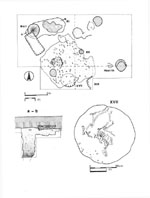 The agricultural activity of the settlement is indicated by the many
store pits. The lower part of one of them was plastered over and baked in
order to keep the cereals dry. The pits were cylindrical or so-called pear-shaped.
On the strength of the remains of the cereals, it can be stated that they
grew triticum dicoccum, the type of wheat used by the aboriginals and
in the Barbaricum, in contrast with the triticum aestivum, which
was used by the Romans and which yielded heavy crops. In one of the pits,
a skeleton of a deer was found (Pic. IV.3.), which can be connected to the
abundance and fertility cult.
The agricultural activity of the settlement is indicated by the many
store pits. The lower part of one of them was plastered over and baked in
order to keep the cereals dry. The pits were cylindrical or so-called pear-shaped.
On the strength of the remains of the cereals, it can be stated that they
grew triticum dicoccum, the type of wheat used by the aboriginals and
in the Barbaricum, in contrast with the triticum aestivum, which
was used by the Romans and which yielded heavy crops. In one of the pits,
a skeleton of a deer was found (Pic. IV.3.), which can be connected to the
abundance and fertility cult.
A few hundreds meters away from villa Nr. II in Tác, in Tác-Margittelep find-place, the aboriginals’ dug-in beam houses with 2-4 and 6 stays, came up together with ovens.
In Szabadegyháza-Büdöstó nad Boglárlelle-Rádpuszta find-places, houses sank into the soils and remains of rammed wall were excavated. Similar forms of settlements could exist on the territory of the villae as well, probably with similar houses and agricultural activity. In the territory of the villa in Szentendre, three similar living pits were excavated together with La Téne D pottery fragments, here, however, continuity cannot be observed. Traces of Celtic settlements were found in Petőháza-Lésalja, but it cannot be stated unambiguously whether they are pre-Roman age or living on Celtic settlements.
Continuation of these settlements after the Roman occupation
The Romans either totally destroyed the fortified oppida of the aboriginals, or they integrated the settlements along the limes into the frontier defense system, and moved the inhabitants to the internal areas of the province, auxiliary forces taking their place along the limes (e.g. Esztergom, Dunaszekcső, Stari Slankamen). The majority of the non.fortified cletic settlements live to see the conquest, indicated also by the stray finds of the Roman age (e.g. Lébény-Magaspart), but continuous continuity can very rarely be traced (see the case of Szakály), most of the Celtic settlements come to an end in the period of the conquest together with the La Téne D cemeteries. The former settlement on the territory of the villae do not live on the Roman age, we only possess data on continuity from the Kapos-völgy, where the living on can be partly explained by the lack of the villae.
In strategically and militarily less significant territories, they live on according to the Szakály aboriginal traditions during the Roman age, which is indicated by the lot of Celtic and small number of Roman finds. The lack of the mortarii –one of the most characteristic roman household instrument and one of the signs of Romanization –also indicates the living on of the aboriginal tradition. Due to the marginality of the territory, the aboriginal properties were not organized into villa holdings, we do not possess any data on the municipalization of the territory either, and thus the aboriginals’ settlement and agricultural traditions could live on, which –opposite to the organized villa holdings –pursued the not very productive “changes of wild-ground” method (“rückzugslandschaft”).
In the territory of the boii, the living on can only be revealed where there is a lack of villae: on the western part of the province, where we can find many tumuli and aboriginal settlements, but no villae. Contrary to this, on the eastern part of the territory built in with villae, we cannot find any traces of living on.
New settlements in native tradition under Roman command
After the Roman occupation on the strategically important territories –mainly along the limes –the oppida of the Celtic population was integrated into the frontier defense system, and the population of the settlements removed. This is why, in these territories continuity cannot be revealed between the aboriginal settlements of the pre-Roman age and the Roman age. In the Aquincum area, new aboriginal settlements came into existence even before the Flavius age around the camps of the auxiliary forces (e.g. Óbuda-Újlak), the other half of the population was at the same time removed behind the frontier line. This can be proved by the settlement established in the turn of the 1st and 2nd century and excavated in Csúcshegy-Harsánylejtő, where besides the finds clearly attachable to the Celtic aboriginals, the conscious shaping of the settlement, the previous landscaping indicates roman intervention and organized settling. The new settlement of the local population can be traced in Békásmegyer too. There can be prevailed until the middle of the 2nd century AD. the temporary settlement groups of huts, from the middle of the 1st century with wattle-and-daub, after that with stone-patched wall, later with stone-wall, consisting of 1-2 rooms. The new local ceramics with Celtic origins (comb-impressed decoration, grey pot, bowls, storage vessles, graphitic vessels) and fewer roman finding are characteristic of the new settlements farther from the line of the limes. Besides the traditional way of life, the signs of Romanization can be traced as well: in the cemetery near the settlement in Csúcshegy, the tradition of the setting up of tombstones can be discovered: on one of the tombstones the husband is seen lying on a kline in roman clothing, and her wife is standing besides him in traditional Celtic clothing.
Continuity from native farmhouse to Roman villa
After the Roman occupation, the aboriginals gave up their former agricultural system in most places and their leaders and wealthier strata established roman style villae. These were smaller villa holdings similar to the lands of the veterans. So there cannot be found any continuity between the earlier agricultural forms and the roman villa holdings, the occupation was followed by the reorganization of the lands, the setting of veterans, then, with the municipalization landed properties were torn from the territories of the former village communities and given to town office holders. The villa as an architectural form followed totally new principles and groups plans, continuity and the impact of aboriginal architecture cannot be found here either.
Discontinuity between native settlements and Roman villa landscapes
As we cannot found any connection between the aboriginal settlements and the roman villa holding established later in their place, all of the villae in the area of which early finds came up belong to the category of discontinuity. Late La Téne ceramics was found –without any important distinguishing marks referring to the settlement –among others from Hosszúhetény-Somkerékdűlő. Gyulafirátót-Pogánytelek, Békásmegyer find places. Traces of dug-in living pits can be found in the territory of the villae in Szentendre, Balatonfűzfő, Berhida, Pomáz-Lugi-Dűlő. All of these villae were, however, established later. The discontinuity is especially sharp in the case of the villae in the Aquincum area, where all of the known villae came into existence after the Marcomannian wars.
Economical basis of the villae
At the beginning the goods needed for self-sufficiency were produced in the villae, later on with the appearance of specialized workshops, they began to produce for the market as well. The large estates, which besides the slaves pursued industrial production with the use of fee manpower as well, became the important part of the economic life of Pannonia besides the bigger towns and the centers along the limes. In the late Roman age, the coloni and inquilini played a more and more significant role in the production of the villae.
On the basis of the various types of tools it can be stated that different industrial and agricultural sectors could appear in the same holding. The most common agricultural activity was cereal cultivation, which is also indicated by the frequently appearing iron tools: ploughs sickles, pitch forks and scythes. Among the significant tool finds we should mention the scythes found in Baláca, Kékkút, Szentgál and Großwarasdorf; the ploughshare from Eisenstadt, the sickles known from Gyulafirátót-Pogánytelek and Hajmáskér; and also the assemblidge of artifacts from the villa n Ravazd consisting of pitch forks, scythes and sickles. On the strength of the finds in Baláca, it can be stated that the holdings cultivated the wheat used by the Romans (triticum aestivum), contrary to the wheat used by the aboriginals (triticum dicoccum). The mementos of the wheat processing are those milling stones which were found in the territory of the rest of the villae (Kékkút, Winden am See, Pomáz-Lugi-dűlő)
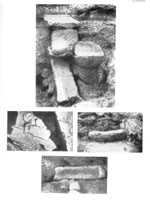 Domitian’s order could have set back the wine culture in principle, because
it prohibited the planting of new vineyards and ordered the eradication of
half of the existing ones –but it was not successful. In spite of this we
haven’t got unambiguous data regarding the volume of the wine culture in Pannonia:
in Winden am See, a press made of granite and some pruning knife came up from
the first half of the 2nd century AD.. Pruning knives are also known from
Baláca and Gyulafirátót, up to this moment, however, we cannot distinguish
for sure between the wine-press and the oil-press, and also between the pruning
knives used for the nursing of vine-stocks and fruit trees. We possess data
on wine production from the villa in Szentendre: pruning knives, grapes pips
and remains of vine-branches came up. By all means, according to the written
sources, Pannonia was in the need of wine import until the 4th
century AD.
Domitian’s order could have set back the wine culture in principle, because
it prohibited the planting of new vineyards and ordered the eradication of
half of the existing ones –but it was not successful. In spite of this we
haven’t got unambiguous data regarding the volume of the wine culture in Pannonia:
in Winden am See, a press made of granite and some pruning knife came up from
the first half of the 2nd century AD.. Pruning knives are also known from
Baláca and Gyulafirátót, up to this moment, however, we cannot distinguish
for sure between the wine-press and the oil-press, and also between the pruning
knives used for the nursing of vine-stocks and fruit trees. We possess data
on wine production from the villa in Szentendre: pruning knives, grapes pips
and remains of vine-branches came up. By all means, according to the written
sources, Pannonia was in the need of wine import until the 4th
century AD.
Wood-cutting and wood-working was common in most of the places, a lot of iron tools were found, which were used for the cutting and shaping of wood and for the bricklayer’s trade. All of the villae had several wooden buildings, for the maintenance of which the bigger holdings were able to employ carpenters and bricklayers.
The richness of the postures and forests created very good conditions for animal breeding. The tools found in the territory of the villae and used for weaving, and spinning can be connected to this. They could either use fishing net or angle for fishing; fish-spears, net-weighs came up in the territory of the villae. The dams of some fish ponds near the villae can refer to fish-breeding (Pátka, Balf).
We possess many data in connection with the industrial activity of the villae; we know brick kilns from several places. In the villae the self-sufficient brick burning workshops did not put stamps onto their products. 30 metres from the villa in Fertőrákos-Golota, a brick kiln with the dimensions of 5.4x5.5x4.2 metres was found, but only the firebox of it remained, the firing chamber was destroyed. The entrance of the firebox was built of mud-bricks. The kiln was used between the end of the 1st century and the beginning of the 3rd century. Another late Roman villa is known from Fertőrákos, from the Alsóültetvénydűlő find place, which is 3 kilometres from the one in Fertőrákos-Golota. 70 meters from this, a smaller brick kiln was found with the dimensions of 2.4x2.8. Only the firebox remained here too, which was divided into three parts. The kiln probably functioned in the 4th century. In Gyulafirátót a quadrate-shaped brick kiln was found, and we know others from the area of Eisenstadt, Balatonfüred, Szentkirályszabadja, Csopak, Alsóörs, Berhida finds places. From beside the brick kiln in the villa in Eisenstadt Caius Coranius’s inscription, magister figlinarum also came up.
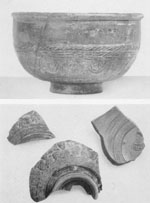 Besides brick burning, significant pottery activity went on as well. In Gyulafirátót,
besides the cooking ware, imitations of terra sigillata with relief
were produced and also good quality stamped pottery. In the pottery works
of the villa in Balatonfűzfő, several ovens were found in which
jugs, plates and pottery with stamp decoration were produced. They probably
supplied the neighboring aboriginal settlements with pottery. On the strength
of the find found in Winden am See it can be proved that they also produced
glazed pottery.
Besides brick burning, significant pottery activity went on as well. In Gyulafirátót,
besides the cooking ware, imitations of terra sigillata with relief
were produced and also good quality stamped pottery. In the pottery works
of the villa in Balatonfűzfő, several ovens were found in which
jugs, plates and pottery with stamp decoration were produced. They probably
supplied the neighboring aboriginal settlements with pottery. On the strength
of the find found in Winden am See it can be proved that they also produced
glazed pottery.
In connection with the metal-work, important finds, such as bronze lamps and
a Minerva-head were excavated in the villa in Örvényes, which could be the
products of the smithery functioning in the 4th century AD. From the villa
in Kaszásdűlő, we know a small metal-processing workshop from the
4th century AD., which is proved by half-made bronze ware, raw materials used
for bronye-casting and iron tools excavated there. Similar metal-casting workshop
is known from Harka-Kányaszurdok. In the villa in Gyulafirátót, a smithery
functioned in the 3rd-4th Century AD., and a furnace used for lead-work
also came up with ingots from the same mould, half-made non-smoothed pieces
and bungled ingots. This workshop produced the small votive lead statues depicting
Isis-Fortuna, Matronae and Silvana, which were found in this villa as well.
We know smithery also from Nagylózs and Petőháza-Lésalja find places.
Flown away “lead-flan” was found in the territory of the villa in Kékkút,
where lead-work could also go on. Besides these, the lime-kiln in Szentkirályszabadja-Romkút
can be ranked among the industrial activities.
Sanctuaries at the villae
Due to the deficiencies in the research of the Pannonian villae and also the unexplained functions of the rooms of the villae excavated, we can only form a picture of the sanctuaries on the basis of the altars, god statue and other objects connected to the worship activity. The most frequent ones are the small domestic sanctuaries with altar and god statues. In the villa in Kaszásdűlő a small Lararium functioned, from which the fragments of a small terracotta statue of Venus and fragments of incense burners probably used during the worship came up. The Lararium in Nagydém, from which bronze lamps, a bronze pitcher and the bronze statue of Laran Apollón came up, could also be a domestic sanctuary of a villa. In Ajka, in a domestic sanctuary probably dedicated to Hercules, the statue of Hercules was found and also an altar stone dedicated to him by Iulia Prisca and P. Sextus Acurius Dexter. From Csajág we know the altars of L. Aurelius Valentinus and L. Aurelius Silvester set up in 216 AD.: on of them was dedicated to Minerva and the other to Iunon. It must have been the domestic sanctuary of the Capitolium’s triad, so there must have existed a third altar dedicated to Iuppiter. Near the altars a Liber Pater statue fragment was also found. The mementos of the Diana-cult are the Diana-relief found in Balatonfőkajár, and an altar from Csopak dedicated to Diana. In Eisenstadt, T. Flavius Seianus duumvir of Carnuntum set up an altar for Diana.
| Lararium in Nagydém |
Hercules |
Iulia Prisca and P. Sextus Acurius Dexter |
| Minerva |
Iunon |
Diana-relief found in Balatonfőkajár
|
In the villa in Budaörs, probably also existed a domesticsanctuary where the altar dedicated to Terra Mater could stand. In the villa in Testvérhegy, a Silvanus-relief was found near a 7-meter-wide paved road, which probably belonged to a crossroads-sanctuary. The bronze votive hand excavated in Ravazd is the memento of the Sabasios-cult of eastern origin. Among the Pannonian villae, the sanctuaries from Eisenstadt are the most conceivable architecturally. The many-sided religious life is indicated by the Diana-altar, Asklépios-relief fragment, the two altars dedicated to Silvanus, the Fortuna-statue, the Priapos-statue, the Mithras-board and the votive mementos made of lead. The altars and statues were found in the various inner parts of the villa, inside the main building there could function the sanctuaries consisting of even 2-3 rooms.
| Besides the roman religion, we can also find mementos of the early Christian religion in the Pannonian villae. In the early Christian basilica of Donnerskirchen, the fragment of the marble altar was found as well. |
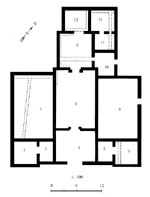
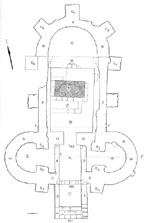 The fragment of the edge of a similar marble table or altar is known
from the territory of the villa in Csopak. Earlier the building of the villa
in Kékkút was also considered to be a basilica, but it was disproved by a
later research. But the two-storey mausoleum and chapel from the 4th century
AD. found near the villa in Kővágószőlős are the mementos of
the early Christian cults for sure. On the first floor there were burial chambers
decorated with geometrical and figure painting, while in the small chapel
with apse on the upper floor, ecclesiastical activity was pursued, which can
be explained by the its closeness to Sopianae, the one of the main centers
of the early Christians.
The fragment of the edge of a similar marble table or altar is known
from the territory of the villa in Csopak. Earlier the building of the villa
in Kékkút was also considered to be a basilica, but it was disproved by a
later research. But the two-storey mausoleum and chapel from the 4th century
AD. found near the villa in Kővágószőlős are the mementos of
the early Christian cults for sure. On the first floor there were burial chambers
decorated with geometrical and figure painting, while in the small chapel
with apse on the upper floor, ecclesiastical activity was pursued, which can
be explained by the its closeness to Sopianae, the one of the main centers
of the early Christians.
Building
Types: Differences between villae in the countryside and near-by towns
The geographical localization of the pannonian villae had several components. The climate, the location of the place and the closeness of the important roads all played an important role in the territorial spreading of the villae.
| Villae in the area of Lake Fertő |
||
Villae in the Balatonfelvidék |
Villae in the area of Aquincum |
|
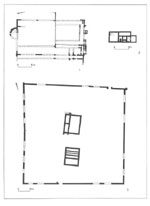 The villa holdings can be divided
into three large groups in Pannonia: the villae in the area of Lake Fertő,
the villae in the Balatonfelvidék and the ones in the area of Aquincum. All
the three areas belonged to the territory of a town: the area of Lake
Fertő to Carnuntum; the Balaton-felvidék to
Mogentiana, the municipal of the Hadrian age, which up to this point cannot
be localized unambiguously.
The area of Aquincum belonged to Aquincum. We have very few information on
the so-called country villae situated in the interior territories
of the country, partly due to the concentration of the villae mentioned above
and the deficiencies of the research. This is why we have to commit ourselves
to the general features when talking about the differences between the country
villae and the ones near towns: the richer, luxurious villae were built
by
the municipal aristocrats close to the towns, the villae on the marginal
territories, far from the towns and important roads were presumably poorer.
It can be proved
in the area of Aquincum that besides the veterans mainly territorial administration
officials lived close to the towns, while moving away from the town we
know
more and more town clerks and landowners belonging to other strata. The far-away
country villae often possessed by town clerks (see Indication
of the villa owner ).
The villa holdings can be divided
into three large groups in Pannonia: the villae in the area of Lake Fertő,
the villae in the Balatonfelvidék and the ones in the area of Aquincum. All
the three areas belonged to the territory of a town: the area of Lake
Fertő to Carnuntum; the Balaton-felvidék to
Mogentiana, the municipal of the Hadrian age, which up to this point cannot
be localized unambiguously.
The area of Aquincum belonged to Aquincum. We have very few information on
the so-called country villae situated in the interior territories
of the country, partly due to the concentration of the villae mentioned above
and the deficiencies of the research. This is why we have to commit ourselves
to the general features when talking about the differences between the country
villae and the ones near towns: the richer, luxurious villae were built
by
the municipal aristocrats close to the towns, the villae on the marginal
territories, far from the towns and important roads were presumably poorer.
It can be proved
in the area of Aquincum that besides the veterans mainly territorial administration
officials lived close to the towns, while moving away from the town we
know
more and more town clerks and landowners belonging to other strata. The far-away
country villae often possessed by town clerks (see Indication
of the villa owner ).
Endowment of villas
In the identification of the Roman villae it is often the presence of the fragments of stuccos, plasters, wall-paintings which plays a critical role. Smaller fragments of wall-paintings often can be found in the territory of the villae, but we know only a few villae which are richly decorated. The villa in Baláca is one of the most richly decorated Pannonian villae. Mosaic floors were found in some of the rooms, and the chessboard-patterned mosaics with floral ornamentation of the 8th room follows the Italian early black-and-white style, and began to spread in Pannonia in the Severan-age. Similar mosaic consisting of black-and-white geometrical motifs was found in the 10th room as well. The most beautiful mosaics were found in the 31st and 21st room. The polychrome mosaic of the 31st room consists of a quadrate-shaped field an apse. Cantharos can be seen in the apse. The main field consists of 6x4 squares, where floral, geometrical and pelt motifs alternate with each other. In the central picture field, a fruit tree and two birds can be seen surrounded by a multi-coulour guilloche. The mosaic in the 21st room is similar to that of the 31st room: it consists of a quadrate-shaped main field and an apse, and also the cantharos-motif can be found on it. Besides the mosaics we know numerous wall-paintings from the villa in Baláca, probably the most important of them is the so-called “yellow-lilac room”, which possess a cosmological view programme.
The “yellow-lilac room” consists of yellow picture fields divided by yellow dividing stripes and lilac skirting board. The top section of one of the scenes already reconstructed is bordered with richly decorated stucco-cornice and an ornamental row decorated with flowers. In the dividing stripe, we can find the contours of several buildings and also a candelabra; the skirting board depicts sedge and water birds. The images of the “yellow-lilac room” are the most beautiful and most prominent mementos of the art of wall-painting. Another important wall-painting from Baláca is the ceiling-fresco from the II. century which depicts a vintage scene. Dionysian thiasos scene can be seen on it with Dionysus, “yellow-lilac room” Silenos and the maenads. We should mention the child Dionysus figure of the so-called “black room” and the wall-paintings of the so-called “red-black room”.
Child Dionysus
figure of the so-called “black room” |
Wall-paintings of the so-called “red-black room” |
Ornamentation of such quality comparable to the Baláca is only known from the villa in Parndorf., here Bellerophon-Chimaera mosaic, mosaic depicting Diana-bust and several geometrical mosaic floor came up from the 4th century AD.. Mosaics with various geometrical motifs were found in the villae in Deutschkreuz, Šmaje-Grobelce and Šmarje-Pristova. Apart from this, we only know a white-black-red-green-darkblue-colured mosaic floor with simple opus sectile technique from the villa in Örvényes.
Bellerophon-Chimaera mosaic |
Mosaic depicting Diana-bust |
Several geometrical mosaic floor |
Mosaics with various geometrical motifs in the villae
in Deutschkreuz |
In the Aquincum area, we know two richly decorated villae; the caldarium with an apse and a neighboring representation room in the Csúcshegy villa possess wall-paintings divided into colourful picture fields, with marble-imitative skirting board and also decorated stuccos, cornices depicting running animals and a stucco-relief depicting a vintage scene. The other villa possessing wall-paintings is the recently excavated one in Szőlőskert street.
Smaller fragments of wall-paintings came up in several villae, e.g. in Pomáz-Lugi dűlő. Örvényes, Gyulafirátót, Kékkút, Balatonalmádi.
Indication of the villa owner
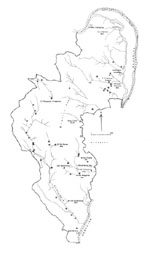 We can form a picture on the ownership of the villae on the basis of
the inscriptions found in the territory of the villae. We possess the most
information on the owners of the villae and the estate conditions in the Aquincum
area. In the area Aquincum, the municipal medium estates had a low importance
before the Marcomannian wars, the villa holdings –appearing already in the
1st-2nd century AD. in other places -came into existence only from
the Severan-age. Before the Marcomannian wars the free peasant landed property
could be the dominant form of agricultural, the few medium landowners were
settled veterans. We know only a few inscriptions indicating the presence
of slaves, liberti From 124 AD. when Aquincum became a municipium landed
properties were torn from the territories of the former village communities
and given to the members of the ordo decurionum, and thus the
municipal medium estates began to develop. On the basis of their family names,
the decuriones were mainly local aboriginals.
We can form a picture on the ownership of the villae on the basis of
the inscriptions found in the territory of the villae. We possess the most
information on the owners of the villae and the estate conditions in the Aquincum
area. In the area Aquincum, the municipal medium estates had a low importance
before the Marcomannian wars, the villa holdings –appearing already in the
1st-2nd century AD. in other places -came into existence only from
the Severan-age. Before the Marcomannian wars the free peasant landed property
could be the dominant form of agricultural, the few medium landowners were
settled veterans. We know only a few inscriptions indicating the presence
of slaves, liberti From 124 AD. when Aquincum became a municipium landed
properties were torn from the territories of the former village communities
and given to the members of the ordo decurionum, and thus the
municipal medium estates began to develop. On the basis of their family names,
the decuriones were mainly local aboriginals.
After The Marcomannian wars and the turning of Aquincum into a colony (194), the situation changed: contrary to the other territories in Pannonia, where the early villa holdings had difficulties in recovering from the destruction the Marcomannian wars and began to decline in the Severan-age, in the area of Aquincum, the earliest villae were founded at this time, and the municipal medium estates began to develop at this time as well. Also the number of inscription mentioning the slaves, liberti increased. With this the composition of the stratum of land-owners changed as well. From the one hand, the town aristocrats struggled to stabilize their financial situation by the acquisition of lands, on the other hand, landed properties were distributed among the members of the Augustalis- and sevir-boards. It can be proved that the lands close to the town were possessed by veterans and territorial administration officials, while moving away from the town we know more and more town clerks and landowners belonging to other strata. The composition of the land-owners changes with regard to their ethnicity as well, besides the local Romanized people we know more and more land-owners of eastern origin: Bithynia Severa or M. Aurelius Aepictetianus can be good examples for the family names of eastern origin.
The following villa owners can be identified on the basis of their inscriptions from the Aquincum territory.
Békásmegyer: M. Aurelius Aepictetianus
Biatorbágy: Ulpius Valentius
Budakeszi: Aurelia Castoriana
Budaörs: M Aurelius Victorinus duumvir, C. Iulius Maximianus decurio, M. Aurelius Fronto
Csúcshegy: T. Mercasius Hermes
Dunabogdány: Aur. Marcus decurio
Érd: M. Ulpius Quadratus decurio
Nagykovácsi: Septimius Celer sexvir
Páty: M. Ulpius Karus decurio
Piliscsaba: C. Pomp.Crispinus
The area of Szenetendre-Pomáz: L. Atticius Atticinus decurio, T. Fl. Felicio Augustalis,
C. Atticus Verecundus
Testvérhegy: Bithynia Severa
Törökbálint: M. Aurelius Epigonus decurio
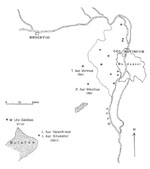 The municipal aristocracy could possess several other country estates
besides the villae in the Aquincum area. This is indicated by the altars of
L. Aurelius Valentinus and L Aurelius Silvester decuriones set up in
Csajág, and also M. UlpiusGaddas’s inscription from Veszprém.
The municipal aristocracy could possess several other country estates
besides the villae in the Aquincum area. This is indicated by the altars of
L. Aurelius Valentinus and L Aurelius Silvester decuriones set up in
Csajág, and also M. UlpiusGaddas’s inscription from Veszprém.
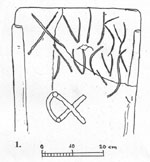 Regarding the other parts of Pannonia we possess fewer data on the ownership
of the villae and the estate conditions. In the Balaton-felvidék we can reckon
mainly with italicus land owners, which is supported by the Aquileian
merchants who moved here in the 1st century AD. (Opponii, Caesernii, Canii).
The supposition came up that in this territory, the system of large estates
was already developed in the 1st century AD., this is indicated by those place
names which originate from adjectives formed from gentilicii or congnomina
with -iana, -ianis affixes (Morgentiana, Bassiana, Caesariana, Mansuetiana,
Cariniana, Tricciana, Cimbriana, etc.), where the names might refer to the
first owner of the villa, and in the case of Caesariana, to imperial estates.
On the basis of a TEGULA with X VIKVS / AVGVS(TI) / α inscription, the
villa in Baláca could be the center of Caesariana, imperial saltus.
Regarding the other parts of Pannonia we possess fewer data on the ownership
of the villae and the estate conditions. In the Balaton-felvidék we can reckon
mainly with italicus land owners, which is supported by the Aquileian
merchants who moved here in the 1st century AD. (Opponii, Caesernii, Canii).
The supposition came up that in this territory, the system of large estates
was already developed in the 1st century AD., this is indicated by those place
names which originate from adjectives formed from gentilicii or congnomina
with -iana, -ianis affixes (Morgentiana, Bassiana, Caesariana, Mansuetiana,
Cariniana, Tricciana, Cimbriana, etc.), where the names might refer to the
first owner of the villa, and in the case of Caesariana, to imperial estates.
On the basis of a TEGULA with X VIKVS / AVGVS(TI) / α inscription, the
villa in Baláca could be the center of Caesariana, imperial saltus.
The Gyulafirátót-Pogánytelek villa was connected to veteran deduction. In the area of Winden am See we can speak of italicus land owners. From Eisenstadt, the altar of T. Flavius Seianus duumvir of Carnuntum is known. In Ajka, Iulia Prisca nad P. Sextus Acurius Dexter set up an altar. Besides these, three signet-ring was found in the villa in Ravazd, on the basis of which the owners could be Caius Ernatus Primigenius, L.A.F and P.E.D. On the basis of the M. Cocceius Campianus pr(aefectus) v. pr(inceps) c(ivitatis) B(oiorum) epitaph in the Parndorf villa, one of the owners of the villa had been supposed to be one of the members of the boi aristocracy, but the new research proved that what happened was that the tombstone was used for the second time. The villa could be the center of an imperial estate and is probably identical with the Villa Murocincta.
Summary
Due to the deficiencies of the research many aspects of the relationship between the Pannonian villae and Romanization are difficult to examine. The archeologically documented villae are concentrated to 3 main territories: the area of Lake Fertő, the Balaton-felvidék and Aquincum. Due to the natural circumstances and the concentration of estates, we haven’t got many data on the “interior” county territories, most of the villae known are from those territories mentioned above, and the archaeological research also gave preference to them. According to the early settlements, tt can generally be stated that the Romans either totally destroyed the fortified oppida of the aboriginals, or they initiated the settlements along the limes into the frontier defense system, and moved the inhabitants to the internal areas of the province. In the territory of the roman villa holdings, the living on of the aboriginal settlements cannot be proved, because the villae either developed much later than the giving up of the settlements, or they reformed the aboriginal settlements according to the new roman agricultural and estate system. And the new aboriginal settlementsdveloped during the Roman age cannot be considered as the continuation of the earlier ones, since they were established in new territories.
The most important role of the villa holdings was the agricultural and industrial production, besides the widely spread agricultural activity proved by the many iron tools, significant industrial activity also went on in the villae. Besides the pottery and brick burning workshops, we could also find there traces of metal procession and other branches of industry. The economic potential of the villae is comparable to that of the industrial centers along the limes.
The owners of the villae were composed of various large strata. The owners of the luxurious villae and large estates were from the leadership of the provincial and municipal administration. The town clerks also possessed significant landed properties, members of other social strata can also be revealed among the owners of the villae. Most of the small lands were in the hands of settled veterans.
The relationship between the villa holdings (introduced by the Romans and more productive than the aboriginal methods) and the aboriginals, and also the examination of the Romanization from an industrial-economic pint of view, and the comparing of it with other territories are all form an important part in the roman provincial research, which can increase with further excavations and research.
An example of a roman villa: The Baláca villa
The villa in Nemesvámos-Balácapuszta, member of the villae in the Balaton-felvidék, is one of the best-researched Pannonian villae and is also an interesting example of a typical Pannonian villa from various points of view.
Regarding the villae in the Balaton-felvidék, the aboriginal-roman continuity cannot be prevailed, we can mainly reckon with italicus land owners, which is supported by the Aquileian merchants who moved here in the I. century (Opponii, Caesernii, Canii). The supposition came up that in this territory, the system of large estates was already developed in the 1st century AD., this is indicated by those place names which originate from adjectives formed from gentilicii or congnomina with -iana, -ianis affixes (Morgentiana, Bassiana, Caesariana, Mansuetiana, Cariniana, Tricciana, Cimbriana, etc.), where the names might refer to the first owner of the villa, and in the case of Caesariana, to imperial estates. Nowadays this supposition is questioned, however. On the basis of a TEGULA with X VIKVS / AVGVS(TI) / α inscription(Pic.IV.55), the villa in Baláca could be the center of Caesariana, imperial saltus, which got wedged in between the territories of saltus Mogentiana and Aquincum and its centre could be somewhere in the eastern part of Veszprém.
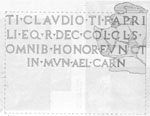 We know about the owners of
the villa on the basis of the epitaphs of Italian-modeled tumulus. The tumulus
was the burial place of Romanized local family with Pannonian origin, which
was granted civil rights under Caesar Claudius.
They began to bury into the tumulus in 100 A.D, and it was used by three
generations of the family until around 160/170. The villa and the burial place
was presumably left during the wars of 167-180. According to the epitaph of
Tiberius Claudius Aprilis, one of the owners of the villa, it can be revealed
that he was not only the colonia decurio of Savaria, but also occupied
all the positions of the Carnuntum municipium established by Hadrianus,
and he probably became the member of the order of knighthood as well:
We know about the owners of
the villa on the basis of the epitaphs of Italian-modeled tumulus. The tumulus
was the burial place of Romanized local family with Pannonian origin, which
was granted civil rights under Caesar Claudius.
They began to bury into the tumulus in 100 A.D, and it was used by three
generations of the family until around 160/170. The villa and the burial place
was presumably left during the wars of 167-180. According to the epitaph of
Tiberius Claudius Aprilis, one of the owners of the villa, it can be revealed
that he was not only the colonia decurio of Savaria, but also occupied
all the positions of the Carnuntum municipium established by Hadrianus,
and he probably became the member of the order of knighthood as well:
[Ti(berio) Claudio Ti(berii) f(ilio)] Apri-
[li eq(uiti) R(omano) (?) dec(urioni) (?) c]ol(oniae) Cl(audiae) S(avariae)
[omnib(us) honour(ibus)] funct(o)
[in mun(icipio) Ael(io) Ca]rn(unto)
The Baláca villa belongs to the earliest villae; its first period can be dated back to the last third of the I. century on the basis of the ground-plan and the wall-paintings of the dining hall, the red-black room the green-lilac room and the black room. The mosaic floors of the 20th and 31st rooms refer to another period, probably the middle of the 2nd century AD. In the third period of the villa (end of 2nd century- beginning of 3rd Century), the earlier wall-paintings were knocked off and used for the grounding of the new period. This was the period when the villa received its final form, later on only smaller reconstructions took place. The villa in Baláca is one of the most richly decorated Pannonian villae. Mosaic floors were found in some of the rooms, and the chessboard-patterned mosaics with floral ornamentation of the 8th room follows the Italian early black-and-white style, and began to spread in Pannonia in the Severan-age. Similar mosaic consisting of black-and-white geometrical motifs was found in the 10th room as well. The most beautiful mosaics were found in the 31st and 21st room. The polychrome mosaic of the 31st room consists of a quadrate-shaped field an apse. Cantharos can be seen in the apse. The main field consists of 6x4 squares, where floral, geometrical and pelt motifs alternate with each other. In the central picture field, a fruit tree and two birds can be seen surrounded by a multi-coulour guilloche. The mosaic in the 21st room is similar to that of the 31st room: it consists of a quadrate-shaped main field and an apse, and also the cantharis-motif can be found on it. Besides the mosaics we know numerous wall-paintings from the villa in Baláca, probably the most important of them is the so-called “yellow-lilac room” , which possess a cosmological view programme. The “yellow-lilac room” consists of yellow picture fields divided by yellow dividing stripes and lilac skirting board. The top section of one of the scenes already reconstructed is bordered with richly decorated stucco-cornice and an ornamental row decorated with flowers. In the dividing stripe, we can find the contours of several buildings and also a candelabra; the skirting board depicts sedge and water birds. The images of the “yellow-lilac room” are the most beautiful and most prominent mementos of the art of wall-painting. Another important wall-painting from Baláca is the ceiling-fresco from the 2nd century AD. which depicts a vintage scene. Dionysian thiasos scene can be seen on it with Dionysus, “yellow-lilac room” Silenos and the maenads. We should mention the child Dionysus figure of the so-called “black room” and the wall-paintings of the so-called “red-black room”.
Child Dionysus figure of the so-called “black room” |
Wall-paintings of the so-called “red-black room” |
Bibliography:
Alföldy 1959 = Alföldy G., ’Municipális középbirtokok Aquincum környékén’ Antik Tanulmányok 6(1959) 19-30.
Alföldy 2004 = Alföldy G., ’Die Inschriften des Hügelgräbers von Baláca’ Balácai Közlemények VIII(2004) 23-122.
Burger 1985-86 = Burger, A., ’The Roman Villa and Mausoleum az Kővágószőllős, near Pécs(Sopianae)’ Janus Pannonius Múzeum Évkönyve 30-31(1985-86) 65-228.
Gabler 1982 = Gabler, D., ’Aspects of the Development of Late Iron Age Settlements into the Roman Period in Transdanubia’ Studies in the Iron Age of Hungary, BAR Int.Ser. 144, Oxford 1982, 65.
Gabler 1993-94 = Gabler D., ’A Balatontól északra lévő terület római kori településtörténetének néhány kérdése’ Veszprém Megyei Múzeumok Közleményei 19-20(1993-1994) 149-155.
Gabler 1994 = Gabler, D., ’Die ländliche Besiedlung Oberpannoniens’ in: Bender, H. – Wolff, H.(hrsg.), Ländliche Besiedlung und Landwirtschaft in den Rhein – Donau – Provinzen des Römischen Reiches, Passau 1994, ???
Kiss 1973 = Kiss, Á., Roman Mosaics in Hungary, Budapest 1973.
Kocztur 1972 = Kocztur, É., ’Ausgrabungen in südlichen Stadtviertel von Gorsium/Tác-Margittelep’ Alba Regia 13(1972) [1974] 69-.
Kovács-Fehér 2001 = Kovács P. – Fehér B., ’Feliratos tégla- és edénytöredékek a balácai római kori villából’ Balácai Közlemények 6(2001) 159-182.
Lányi 1990 = Lányi V., ’Villák és vidéki kőépületek’ in: Fitz J. – Mócsy A.(szerk.) Pannonia régészeti kézikönyve, Budapest 1990, 222-234.
Mócsy 1959 = Mócsy, A., Die Bevölkerung von Pannonien bis zu den Markomannenkriegen, Budapest 1959.
Palágyi 1985 = Palágyi, S., ’Über römischen Villen in Pannonien’ Das Altertum 31(1985) 158-163.
Palágyi 1993-94 = Palágyi S., ’Római kori téglaégető kemencék Veszprém megyében’ Veszprém Megyei Múzeumok Közleményei 19-20(1993-94) 215-228.
Soproni 1993-94 = Soproni S., ’Közöletlen római feliratok a Laczkó Dezső Múzeum gyűjteményéből’ Veszprém Megyei Múzeumok Közleményei 19-20(1993-94)141-148.
Soproni 1994 = Soproni, S., ’Ein römischer Villenbesitzer aus Aquincum’ Balácai Közlemények 3(1994) 312-320.
Szentléleki 1965 = Szentléleki T., ’Az örvényesi bronzmécses’ Veszprém Megyei Múzeumok Közleményei 4(1965) 103-110.
Thomas 1964 = Thomas, E., Die römischen Villen in Pannonien, Budapest 1964.
Visy 1994 = Visy, Zs., ’Die ländliche Besiedlung und Landwirtschaft in Niederpannonien’ in: Bender, H. – Wolff, H.(hrsg.), Ländliche Besiedlung und Landwirtschaft in den Rhein – Donau – Provinzen des Römischen Reiches, Passau 1994, 421-.
Zsidi 1994 = Zsidi, P., ’Die römische Villa von Kaszás-dűlő-Siklós utca, und die Frage der Villen im Territorium des Municipium von Aquincum’ Balácai Közlemények 3(1994) 292-311.
